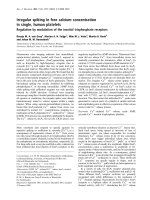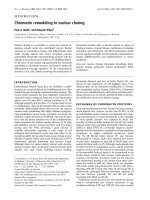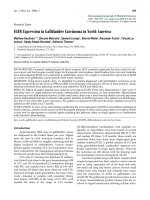Báo cáo y học: " Evolving dimensions in medical case reporting" ppt
Bạn đang xem bản rút gọn của tài liệu. Xem và tải ngay bản đầy đủ của tài liệu tại đây (355.96 KB, 3 trang )
EDIT OR I A L Open Access
Evolving dimensions in medical case reporting
Aristotle D Protopapas
1*
and Thanos Athanasiou
2
Abstract
Medical case reports (MCRs) have been undervalued in the literature to date. It seems that while case series
emphasize what is probable, case reports describe what is possible and what can go wrong. MCRs transfer medical
knowledge and act as educational tools. We outline evolving aspects of the MCR in current practice.
The full translational potential of medica l case reports
(MCR s) is not always considered by authors, periodical s
or readers, as MCRs are often perceived as a low-budget
form of publication for fledgling medical writers. The
acceptance rate for MCRs and their priority for publica-
tion are lower than those for other manuscripts in tradi-
tional journals. It is important to emphasize that
prospective, retrospecti ve and observational randomized
controlled trials are always constructed on the basis o f
data obtained from individual patients whose cases are
the units that create the cohort, allowing the investiga-
tor to define end points and make inferences by calcu-
lating effect sizes. It is safe to say that all classes of
evidence (Classes I through III) are constructed using
the accumulated units of observation comprising indivi-
dual cases. Although MCRs are limited by the fact that
they cannot be generalized beyond the context of the
individual patient or patients described [1] and thus are
not suitable for inference, they offer a high degree of
opportunity to transfer medical knowledge and act as
educational tools, and in a very direct way.
In this editorial, we attempt to outline the evolving
dimensions of MCRs in four particular areas of medical
education: (1) reporting of adverse events (AEs), (2) new
dis eases or exceptional enviro nments, (3) medical inno-
vation and (4) appropriate use of media in terms of
ethics, standardization and creativity (Figure 1).
MCRs of adverse events: errors of omission or
errors of commission?
An AE is an unwanted event that occurs i n the course
of treatment, especially in a clinical trial. MCRs may be
the first warning of catastrophic AEs [2,3].
The Journal of Medical Case Reports encourages con-
structive MCRs of AEs, especially the unreported side
effects or adverse interactions involving medications or
unexpected events in the course of treating a patient [4].
An isolated AE can be important in forming part of
the evidence in the healthcare sciences [5]. Some meth-
odologies of randomized controlled trials lead to the
exclusion of such isolated AEs from their data sets,
which renders an isolated MCR of an AE even more
valuable.
It is especially crucial to highlight translational AEs,
where in vitro or animal experiments have not been
reproduced in humans, with resultant ramifications for
patient safety [6]. The evidence in national and interna-
tional AE databases should be consulted, and each AE
should be logged appropriately [7].
Overall, an AE should be reported in an exacting,
scientific way. A root cause analysis should be included,
and a survey of evidence-based recommendations should
conclude the report. Below we present a b rief algorithm
from the generic templat e of JMCR[4]thatsummarizes
the above-mentioned contentions:
1. Introduction: The Introduction should s tate the
indicat ions of the intervention, a brief overview of exist-
ing e vidence a nd current evidence-based recommenda-
tions, preferably tabulated and classified [8].
2. Case presentation: Are case presentations an error
of omission or err ors of commission? Adherence to
recommendations and good practice are essential.
3. Discussion: The Discussion section should translate
findings to clinical best practices and patient safety. In
cases in which a case report describes an AE that
occurred within the setting of a randomized controlled
trial, this should be clearly stated and det ails of the ran-
domized contr olled trial, such as its regist ration and
* Correspondence:
1
28 Old Brompton Road, London, SW7 3SS, UK
Full list of author information is available at the end of the article
Protopapas and Athanasiou Journal of Medical Case Reports 2011, 5:164
/>JOURNAL OF MEDICAL
CASE REPORTS
© 2011 Protopapas and Athanasiou; licensee BioMed Central Ltd. This is an Open Acces s article distributed under the terms of the
Creative Commons Attribution License ( /by/2.0), which permits unrestricted use, distribution, and
reproduction in any medium, provided the original work is properly cited.
relevant reference of the protocol, should be included in
the MCR.
4. Conclusion: The Conclusion section should com-
prise a root cause analysis.
MCRs of new diseases, rare conditions or
exceptional environments
Case reports remain an important source of evidence for
rare conditions or exception al treatment env ironments.
Large trials are not possible in such cases, and MCRs
offer important treatment inform ation. Typical examples
include the description of a new or previously unde-
scribed genetic condition with an atypical inheritance
pattern or the management circumstances of individual
patients in the context of geographic or physiological
extremes (including high altitude and major disasters).
In the absence of larg er data sets, these individual cases
offer valuable information for healthcare practitioners in
treating any similar patients when they occur.
MCRs of innovation
We feel that case reports describing innovative techni-
ques advance healthcare and biotechnology by translat-
ing, validating and finally returning data from individual
patients for further development and refinement of
technologies with a low cost-impact ratio. The major
issu e of biomedical innovation is patient safet y, and this
should be reflected in reporting a novel intervention.
The relevant institutional, national and international
guidelines should provide benchmarks for innovations
and should be adopted in drafting the MCR manuscript.
Appropriate use of media for MCRs: ethics,
standardization and creativity
The expanding role of multi-media in driving home a
message from a case presentation and attracting reader-
ship cannot be overemphasized. JMCR aspires to describe
ethical, high-quality imaging modalities in MCRs.
Ethics
JMCR’ s mandatory policy on consent to publish [9]
applies especially to the explicit consent of the reported
patients to have their images, X-rays and histological
films published. It is also important to keep in mind that
the author guidelines of JMCR state that authors must
preserve the anonymity of the patient [4]. It is expected
that all photographs of humans and reproductions of
medical imaging (for example, computed tomographic
Medical
Case
Reports
(MCRs)
Adverse
Events
New Diseases
or
Exceptional
Environments
Medical
Innovation
Multimedia
Figure 1 Evolving dimensions increasing the educational value of MCRs
Protopapas and Athanasiou Journal of Medical Case Reports 2011, 5:164
/>Page 2 of 3
(CT) scan slices) are stripped of any identifying informa-
tion. The free and open access to JMC R articles renders
these precautions even more important, as the general
public has access to every picture!
Standardization
A small, selective study [10] found a lack of standardiza-
tion and relevance presented in published radiological
images. It is important that th e legend of each image be
accurate and directly relevant to the MCR.
Creativity
Media, being a direct non-verbal mess age per se,should
display creativity in our current Information Age. Digital
photography is currently accessible to most healthcare
organizations around the world, facilitating the capture
and transmission (that is, uploading) of visual data. The
use of medical photography expertise is a sound invest-
ment, yet conventional medical illustrators need to
evolve and diversify from sketching to digitized multi-
media (that is, platform non-specific and viewabl e using
free or widely available tools [4,11]).
The time has come for streaming media to rep lace
traditional forms of media. An example is making whole
CT sequences (axial or three-dimensional), as opposed
to still, selected slices, available in the MCR [11].
Summary
In this era of digitization, case reporting necessitates a
shift of gravitas to patient safety, the application of
improved multi-media and an overall increase in educa-
tional potential. In this brief editorial, we have
attempted to gu ide prospective authors of MCRs in
optimizing their creative writing from ethical and practi-
cal points of view, especially w ith regard to patient
safety. This guidance is meant to complement JMCR’s
general instructions to authors [4].
Author details
1
28 Old Brompton Road, London, SW7 3SS, UK.
2
Division of Surgery and
Cancer, Imperial College London, QEQM Wing, St Mary’s Hospital, Praed
Street, London, W2 1NY, UK.
Authors’ contributions
ADP and TA were equal contributors in writing the manuscript. We both
read and approved the final manuscript.
Competing interests
The authors declare that they have no competing interests.
Received: 28 October 2010 Accepted: 27 April 2011
Published: 27 April 2011
References
1. Doherty M: What value case reports? Ann Rheum Dis 1994, 53:1-2.
2. Kidd M, Hubbard C: Introducing Journal of Medical Case Reports. J Med
Case Rep 2007, 1:1.
3. Joki T, Vaananen I: [Thalidomide and embryopathies: report of 2 cases]
[in Finnish]. Duodecim 1962, 78:822-827.
4. Instructions for JMCR authors. [ />instructions/].
5. Jenicek M: Clinical Case Reporting in Evidence-Based Medicine. 2 edition.
London: Arnold; 2001.
6. Protopapas AD: Anastomotic devices for coronary bypass: lethal
complications have been previously reported! Eur J Cardiothorac Surg
2004, 25:145.
7. Manufacturer and User Facility Device Experience Database (MAUDE).
[ />8. Guirguis-Blake J, Calonge N, Miller T, Siu A, Teutsch S, Whitlock E: Current
processes of the U.S. Preventive Services Task Force: refining evidence-
based recommendation development. Ann Intern Med 147:117-122.
9. Kidd M, Hrynaszkiewicz I: Journal of Medical Case Reports’ policy on
consent for publication. J Med Case Rep 2010, 4:173.
10. Siontis GC, Patsopoulos NA, Vlahos AP, Ioannidis JP: Selection and
presentation of imaging figures in the medical literature. PLoS One 2010,
5:e10888.
11. TeraRecon iNtuition 3D Movie. [ />v=L_ziz60cffo&feature=player_embedded].
doi:10.1186/1752-1947-5-164
Cite this article as: Protopapas and Athanasiou: Evolving dimensions in
medical case reporting. Journal of Medical Case Reports 2011 5:164.
Submit your next manuscript to BioMed Central
and take full advantage of:
• Convenient online submission
• Thorough peer review
• No space constraints or color figure charges
• Immediate publication on acceptance
• Inclusion in PubMed, CAS, Scopus and Google Scholar
• Research which is freely available for redistribution
Submit your manuscript at
www.biomedcentral.com/submit
Protopapas and Athanasiou Journal of Medical Case Reports 2011, 5:164
/>Page 3 of 3









